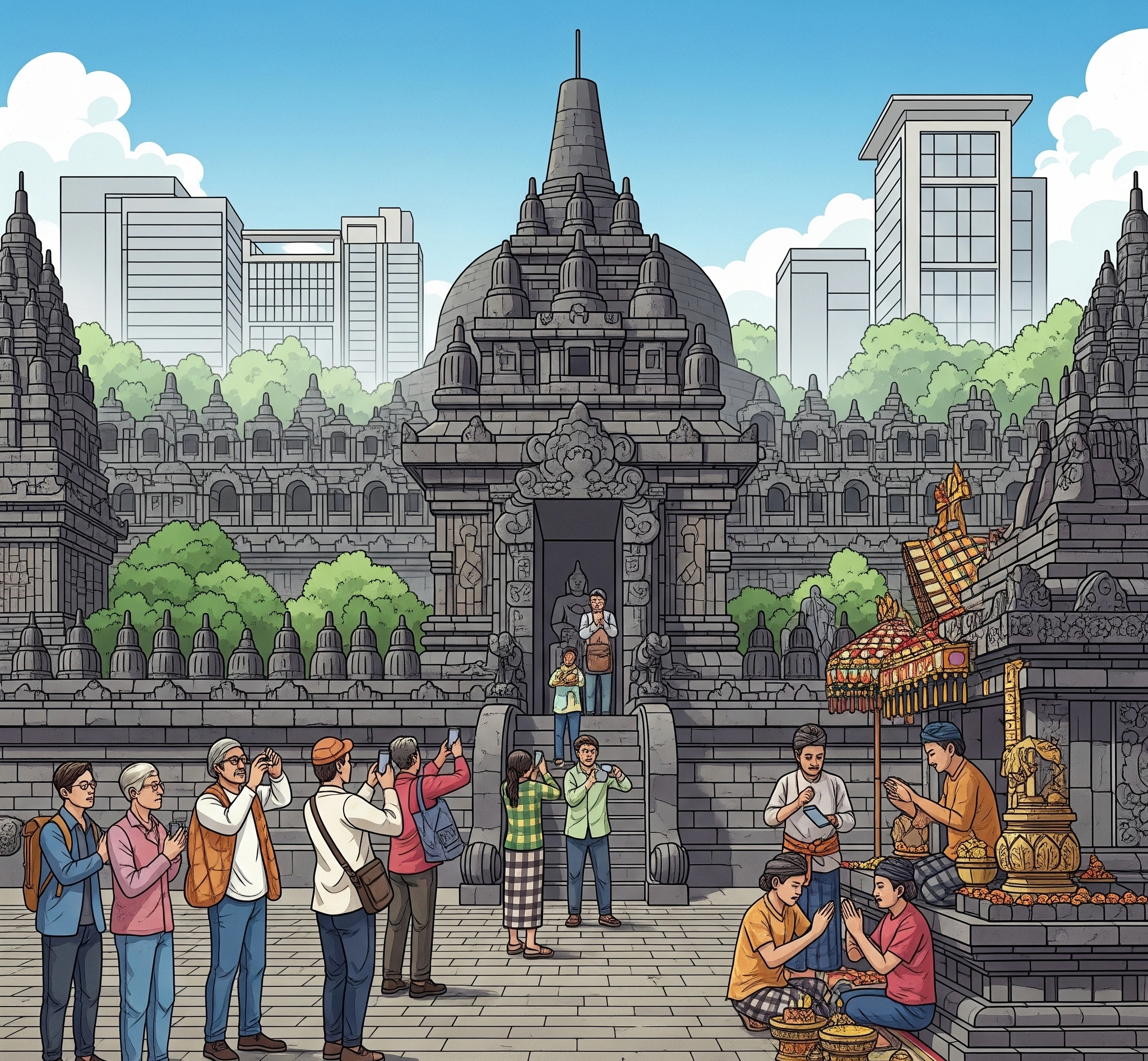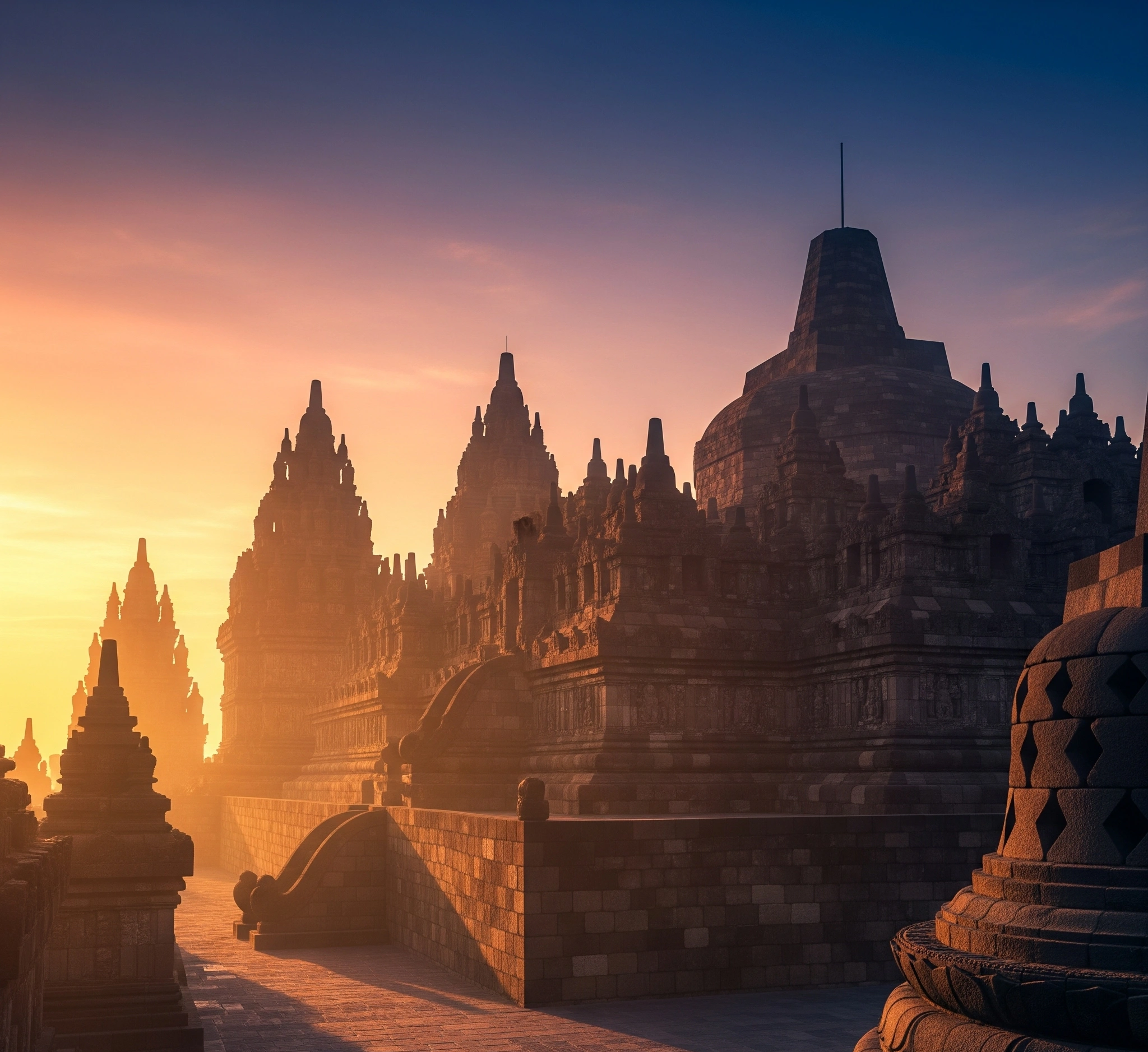
Towering majestically against the Javanese sky, ancient temples like Borobudur and Prambanan inspire awe and wonder. For centuries, their origins have been shrouded in myth, often attributed to divine hands or unknown, mystical forces. Yet, beneath the layers of legend lies a profound human story. This article delves into the truth of the Javanese temple builders, revealing the ingenuity, organization, and dedication of the historical kingdoms and their people. This isn’t about lost magic; instead, it’s a journey into the advanced engineering, sophisticated societal structures, and deep spiritual convictions that truly shaped these monumental achievements.
Table of Contents
- Who Were the Ancient Architects of Java?
- The Pillars of Power: Understanding Royal and Religious Patronage
- Borobudur and Prambanan: Case Studies in Monumental Construction
- Lessons from the Stone: Applying Ancient Ingenuity Today
- The Enduring Legacy: Javanese Temples in Contemporary Society
- Beyond the Myths: The Human Spirit in Stone
Who Were the Ancient Architects of Java?
The ancient temples of Java did not appear by magic. They were the product of highly organized societies and skilled individuals. These magnificent structures emerged primarily during the classical period of Javanese history, roughly from the 8th to the 10th centuries CE. This era saw the rise and flourishing of powerful Hindu-Buddhist kingdoms in Central Java.
The Flourishing of Early Javanese Kingdoms
The Mataram Kingdom, particularly under the Sailendra and Sanjaya dynasties, played a pivotal role. Conversely, the Sanjaya dynasty, a Hindu kingdom, oversaw the creation of the majestic Prambanan temple complex, dedicated to the Trimurti (Brahma, Vishnu, Shiva). These kingdoms possessed the necessary political stability, economic resources, and religious fervor to undertake such colossal projects.
The purpose of these temples extended beyond mere places of worship. They served as cosmic mountains, symbolic representations of the universe, and centers for religious learning and pilgrimage. They also functioned as powerful statements of royal legitimacy and spiritual authority. The construction of these temples, therefore, was a deeply integrated aspect of the state’s political, social, and spiritual life. This effort was driven by human ambition, faith, and the collective will of a civilization. It represents knowledge, not magic; it serves as a guide, not a prophecy, for understanding ancient human achievement.
The Pillars of Power: Understanding Royal and Religious Patronage
The construction of Java’s monumental temples required immense resources, meticulous planning, and a vast workforce. This complex undertaking was made possible by a sophisticated societal structure where various groups played distinct yet interconnected roles.
The King as Patron (Raja): Visionaries and Resources
Visionaries and Resources: The Royal Imperative
The reigning monarch served as the ultimate patron and initiator of temple projects. Kings like Samaratungga (Sailendra dynasty, associated with Borobudur) and Rakai Pikatan (Sanjaya dynasty, associated with Prambanan) provided the vision, commanded the necessary labor, and allocated vast resources from the royal treasury. Their motivations were often a blend of religious devotion, a desire to accumulate merit, and the strategic aim of consolidating power and legitimizing their rule through grand architectural achievements. This role was crucial; without royal backing, such large-scale endeavors would have been impossible.
The Priests and Sages (Brahmana/Biksu): Spiritual Guidance and Design
Spiritual Architects: Guiding the Sacred Design
Religious scholars, priests (Brahmana for Hindu temples), and monks (Biksu for Buddhist temples) were indispensable. They provided the spiritual and iconographic blueprints for the temples. These religious leaders ensured that the temple’s layout, orientation, carvings, and overall symbolism adhered to sacred texts and cosmological principles. They advised the kings and artisans, translating complex philosophical concepts into tangible architectural forms. Their intellectual and spiritual contributions were fundamental to the temples’ profound meaning.
The Artisans and Laborers (Undagi): Skill, Dedication, and Community
Hands That Built History: The Undagi and Workforce
The actual construction was carried out by a highly skilled class of artisans known as undagi. These master builders, stone carvers, sculptors, and engineers possessed sophisticated knowledge of geometry, astronomy, and construction techniques. Beneath them was a massive workforce of common laborers, likely conscripted or communal efforts. They quarried and transported volcanic stone, shaped individual blocks, and assembled the intricate structures. This collective effort, involving thousands of individuals over decades, highlights the immense human dedication and technical prowess of the Javanese people.
The Land and Resources: Material Foundation
From Earth to Edifice: Sourcing the Materials
The abundance of volcanic stone (andesite) in Central Java provided the primary building material. Organizing the quarrying, cutting, and transportation of these massive blocks, often over considerable distances, was a logistical marvel. Furthermore, the fertile agricultural lands supported the large populations required for labor, ensuring food security for the workers. The strategic use of local resources was a testament to their resourcefulness and planning.
Borobudur and Prambanan: Case Studies in Monumental Construction
To truly appreciate the human effort behind Java’s ancient temples, we must look at their most iconic examples: Borobudur and Prambanan. These structures stand as testaments to the organizational genius and technical skill of their builders.
Borobudur: A Mountain of Buddhist Enlightenment
Built around the 9th century CE, Borobudur is a colossal Buddhist monument comprising nine stacked platforms, six square and three circular, topped by a central dome. Its construction involved an estimated 55,000 cubic meters of stone. Imagine the sheer logistics: quarrying, transporting, cutting, and meticulously fitting each stone block without mortar. The temple’s intricate relief carvings, spanning over 2,500 panels, tell stories from Buddhist scriptures, requiring thousands of skilled sculptors. The precision of its design, aligning with cosmic principles, showcases advanced astronomical and mathematical understanding. It was a project of generations, a collective act of devotion and engineering.
Prambanan: A Hindu Ode to the Gods
Constructed shortly after Borobudur, Prambanan is the largest Hindu temple complex in Indonesia. It features tall, pointed architecture, characteristic of Hindu temples, with the central Shiva temple soaring to 47 meters. Its construction involved a similar scale of stone work and an equally intricate array of relief carvings depicting the Ramayana epic. The challenge here was not just the sheer volume of stone, but the architectural complexity of multiple towering shrines, each requiring precise alignment and structural integrity. The builders demonstrated an incredible understanding of load-bearing structures and aesthetic balance. This complex, too, reflects the immense human effort and the sophisticated knowledge of engineering and art that existed in ancient Java. The builders were not mythical figures; they were skilled artisans and dedicated laborers.
Lessons from the Stone: Applying Ancient Ingenuity Today
The legacy of the Javanese temple builders offers profound lessons that resonate even in our modern, technologically advanced world. Understanding isn’t enough; real transformation requires concrete action. The principles that allowed them to construct such enduring masterpieces can inspire our own endeavors.
Embracing Long-Term Vision
Practice: Develop a multi-generational mindset for your projects or goals. Think beyond immediate gratification. Break down large aspirations into smaller, manageable phases, each contributing to the grand design.
Application: For a personal goal like career change, envision the end state decades from now. Then, identify the skills, networks, and experiences needed at each stage. For community projects, consider the lasting impact beyond your tenure.
Philosophical Meaning: The temple builders understood that their work would outlive them. This fosters patience, resilience, and a commitment to quality that transcends individual lifespan, building a legacy.
Fostering Collaborative Endeavors
Practice: Actively seek diverse expertise and foster strong teamwork in your personal and professional life. Recognize that complex problems require varied skills and perspectives.
Application: On a team project, clearly define roles but encourage cross-functional communication. In your community, identify individuals with complementary skills to tackle shared challenges. Learn to delegate effectively.
Philosophical Meaning: The temples were not built by one person but by a collective. This teaches us the power of synergy, where combined efforts achieve far more than individual ones, emphasizing unity and shared purpose.
Mastering Resourcefulness
Practice: Identify and optimally utilize available resources, whether material, intellectual, or human. Think creatively about how to overcome limitations.
Application: If starting a new venture with limited capital, leverage open-source tools and community support. When facing a personal challenge, consider what existing strengths or knowledge you can apply. Recycle and repurpose.
Philosophical Meaning: The builders used local volcanic stone and human power. This highlights the importance of working with what you have, transforming raw materials into masterpieces through ingenuity and perseverance, rather than waiting for ideal conditions.
 The Enduring Legacy: Javanese Temples in Contemporary Society
The Enduring Legacy: Javanese Temples in Contemporary Society
The ancient temples of Java are not mere historical relics; they are vibrant, living symbols that continue to hold immense relevance in the modern world. Their enduring presence bridges the past with the present, offering lessons and inspiration.
Today, these temples are UNESCO World Heritage Sites, attracting millions of tourists annually. They serve as crucial economic drivers for local communities, fostering cultural tourism and providing livelihoods. Furthermore, they remain active centers of worship and pilgrimage for both Buddhists and Hindus, demonstrating the continuity of spiritual traditions. For Indonesians, these temples are powerful symbols of national identity and a rich cultural heritage, instilling pride and a sense of connection to their ancestors.
Beyond tourism and religion, the temples inspire contemporary architects, engineers, and artists. Their sophisticated construction techniques, intricate carvings, and harmonious integration with the landscape offer timeless design principles. They remind us that monumental achievements are possible through vision, collaboration, and perseverance. Ultimately, the temples stand as a testament to human potential, proving that with collective effort and ingenuity, even the most ambitious dreams can be etched into eternity.
Beyond the Myths: The Human Spirit in Stone
The mystery surrounding Java’s ancient temples dissolves when we recognize the extraordinary human effort behind them. They were not built by giants or gods, but by the hands, minds, and spirits of the Javanese people. Their construction represents a remarkable fusion of faith, political will, artistic brilliance, and engineering prowess. These monuments stand as an eternal testament to what humanity can achieve when driven by a shared vision and collective dedication.
“Great works are performed not by strength, but by perseverance.”
— Samuel Johnson
Call to Action
Explore the depths of Javanese history and culture!
Context and References
Internal Links to Related Articles:
- Read more about the history of the Mataram Kingdom.
- Explore the architectural marvels of Southeast Asia.
- Discover the significance of Hindu-Buddhist art in Indonesia.
External References (If Applicable):
- UNESCO World Heritage Centre: Borobudur Temple Compounds
- UNESCO World Heritage Centre: Prambanan Temple Compounds
- Britannica: Java – History
Disclaimer:
This content is provided for historical and archaeological understanding. The construction of these magnificent temples is a testament to human ingenuity and organized effort, rather than supernatural intervention.
About the Author/Source:
This historical insight is shared by The Chronicler of Nusantara — a symbolic figure representing meticulous research, historical accuracy, and cultural appreciation. These writings are meticulously crafted by the [Your Website Name] team, comprised of historical researchers, archaeologists, and cultural experts dedicated to illuminating the human stories behind ancient wonders. We believe that ancestral heritage is not merely a relic, but a profound narrative of human endeavor. Each article is written through a process of extensive research, expert consultation, and deep contemplation, to ensure accuracy and the profound nobility of its contained values. Learn more about our authors and philosophy.